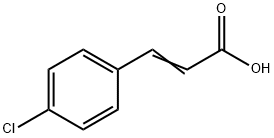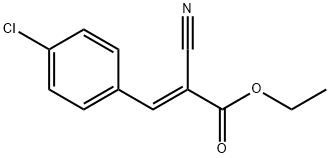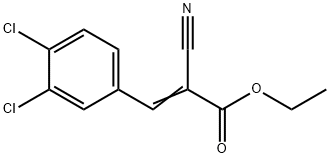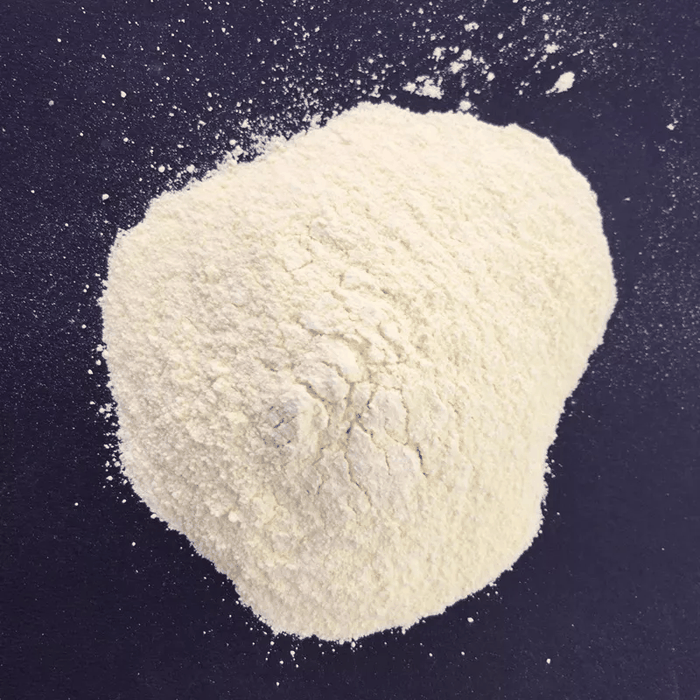4-Chlorocinnamic acid
Synonym(s):trans-3-(4-Chlorophenyl)propenoic acid
- CAS NO.:1615-02-7
- Empirical Formula: C9H7ClO2
- Molecular Weight: 182.6
- MDL number: MFCD00004396
- EINECS: 216-564-8
- SAFETY DATA SHEET (SDS)
- Update Date: 2024-12-18 14:07:02

What is 4-Chlorocinnamic acid?
Chemical properties
white to light yellow crystal powder
The Uses of 4-Chlorocinnamic acid
4-Chlorocinnamic Acid is a derivative of Cinnamic Acid (C442030) and plays an important role in the development of plants. 4-Chlorocinnamic Acid may also show potential antimicrobial, antioxidant, anti-inflammatory, and antitumoral activity.
Definition
ChEBI: 4-chlorocinnamic acid is an organochlorine compound comprising trans-cinnamic acid having a chloro substituent at the 4-position on the phenyl ring. It is functionally related to a trans-cinnamic acid.
Purification Methods
Recrystallise the acid from EtOH or aqueous EtOH (charcoal). UV has max at 275nm (EtOH). [Walling & Wolfstirn J Am Chem Soc 69 852 1947, Beilstein 9 H 596, 9 II 395, 9 III 2727, 9 IV 2033.]
Properties of 4-Chlorocinnamic acid
| Melting point: | 248-250 °C(lit.) |
| Boiling point: | 260.71°C (rough estimate) |
| Density | 1.2377 (rough estimate) |
| refractive index | 1.5426 (estimate) |
| storage temp. | Sealed in dry,Room Temperature |
| solubility | DMSO (Slightly), Ethyl Acetate (Slightly), Methanol (Slightly) |
| pka | 4.41(at 25℃) |
| form | Fine Crystalline Powder |
| color | White |
| BRN | 1365308 |
| CAS DataBase Reference | 1615-02-7(CAS DataBase Reference) |
| NIST Chemistry Reference | p-Chlorocinnamic acid(1615-02-7) |
| EPA Substance Registry System | 2-Propenoic acid, 3-(4-chlorophenyl)- (1615-02-7) |
Safety information for 4-Chlorocinnamic acid
| Signal word | Warning |
| Pictogram(s) |
 Exclamation Mark Irritant GHS07 |
| GHS Hazard Statements |
H302:Acute toxicity,oral H315:Skin corrosion/irritation H319:Serious eye damage/eye irritation H335:Specific target organ toxicity, single exposure;Respiratory tract irritation |
| Precautionary Statement Codes |
P261:Avoid breathing dust/fume/gas/mist/vapours/spray. P264:Wash hands thoroughly after handling. P264:Wash skin thouroughly after handling. P270:Do not eat, drink or smoke when using this product. P280:Wear protective gloves/protective clothing/eye protection/face protection. P304+P340:IF INHALED: Remove victim to fresh air and Keep at rest in a position comfortable for breathing. P305+P351+P338:IF IN EYES: Rinse cautiously with water for several minutes. Remove contact lenses, if present and easy to do. Continuerinsing. P405:Store locked up. P501:Dispose of contents/container to..… |
Computed Descriptors for 4-Chlorocinnamic acid
| InChIKey | GXLIFJYFGMHYDY-ZZXKWVIFSA-N |
4-Chlorocinnamic acid manufacturer
BASR Fine Chemicals Pvt. Ltd.
1Y
Phone:+91-9848230391
Whatsapp: +91-9848230391
product: 4-Chlorocinnamic acid 1615-02-7 98%
New Products
Tert-butyl bis(2-chloroethyl)carbamate 4-Methylphenylacetic acid N-Boc-D-alaninol N-BOC-D/L-ALANINOL 3-Morpholino-1-(4-nitrophenyl)-5,6-dihydropyridin- 2(1H)-one Furan-2,5-Dicarboxylic Acid Tropic acid 1,1’-CARBONYLDIIMIDAZOLE DIETHYL AMINOMALONATE HYDROCHLORIDE R-2-BENZYLOXY PROPIONIC ACID 1,1’-CARBONYLDI (1,2-4 TRIAZOLE) N-METHYL INDAZOLE-3-CARBOXYLIC ACID (2-Hydroxyphenyl)acetonitrile 4-Bromopyrazole 5-BROMO-2CYANO PYRIDINE 5,6-Dimethoxyindanone 5-broMo-2-chloro-N-cyclopentylpyriMidin-4-aMine 2-(Cyanocyclohexyl)acetic acid 4-methoxy-3,5-dinitropyridine 2-aminopropyl benzoate hydrochloride 1-(4-(aminomethyl)benzyl)urea hydrochloride diethyl 2-(2-((tertbutoxycarbonyl)amino) ethyl)malonate tert-butyl 4- (ureidomethyl)benzylcarbamate Ethyl-2-chloro((4-methoxyphenyl)hydrazono)acetateRelated products of tetrahydrofuran





![5-[(4-CHLOROPHENYL)METHYLENE]-2,2-DIMETHYL-1,3-DIOXANE-4,6-DIONE](https://img.chemicalbook.in/CAS/GIF/15851-87-3.gif)


You may like
-
 1615-02-7 4-Chlorocinnamic Acid 98%View Details
1615-02-7 4-Chlorocinnamic Acid 98%View Details
1615-02-7 -
 1615-02-7 99%View Details
1615-02-7 99%View Details
1615-02-7 -
 4-Chloro Cinnamic Acid 98%View Details
4-Chloro Cinnamic Acid 98%View Details
1615-02-7 -
 4-Chlorocinnamic acid 1615-02-7 98%View Details
4-Chlorocinnamic acid 1615-02-7 98%View Details
1615-02-7 -
 4-Chlorocinnamic Acid CAS 1615-02-7View Details
4-Chlorocinnamic Acid CAS 1615-02-7View Details
1615-02-7 -
 trans-4-Chlorocinnamic acid 98% CAS 1615-02-7View Details
trans-4-Chlorocinnamic acid 98% CAS 1615-02-7View Details
1615-02-7 -
 4-Chlorocinnamic acid CAS 1615-02-7View Details
4-Chlorocinnamic acid CAS 1615-02-7View Details
1615-02-7 -
 733039-20-8 5-broMo-2-chloro-N-cyclopentylpyriMidin-4-aMine 98+View Details
733039-20-8 5-broMo-2-chloro-N-cyclopentylpyriMidin-4-aMine 98+View Details
733039-20-8
Statement: All products displayed on this website are only used for non medical purposes such as industrial applications or scientific research, and cannot be used for clinical diagnosis or treatment of humans or animals. They are not medicinal or edible.